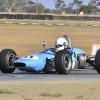Perish the thought that we have the temerity to use the words”cylinder heads”. Hatrat knows what I mean.
I am out of touch a little these days, but do they all still use forged cranks, or steel billet items in FJ cars?
Seeing the FJ cars at the Revival some seem to almost drag their bellies on the track, and they all? seem to use multi adjustable dampers and 2.5” springs as opposed to the original non adjustable fixed items and 1.75” springs. Yes, I know they say they were all later but in period mods. My own still unrestored 20, trial rebuilt, owned since 1990 after being dry stored , in Salt Lake City, since 1969 season end, and full provenance researched with previous owners, still has those springs and dampers, albeit rebuilt by Leda in 1993. For info, the engine was rebuilt, Nick Stagg, to period spec using my Holbay unit, Hollesley Bay plate 1163/167, out of my G4, as it came with a Renault gearbox.
Historic Racing is what it is, as we have discussed before, so let us not try and pretend it is what it was unless a pure period spec is drawn up for every car racing. That would rain on too many people’s parades and that would never do…..
On the subject of new chassis, a replacement chassis car should carry the enforceable designation “type” after its designation. Why, not? When a Mini, TR, Spridget, XK etc has been restored using a new body/chassis unit it is advertised as a key selling point, but clearly cannot claim any sort of period history as it must be a replica, which opens up another can. IMHO Classic Car Insurers should cotton into this. Consider the fine art world as a comparator.
There appears to be a new category of historic class race car, namely the FIA Continuation type, a new build from scratch car to a specific period spec, they say , (let us not talk about power outputs or components….) which receives an FIA Passport which makes no claim to certify provenance or originality. It gets dafter by the minute the more you look into it.
I suspect the 1500cc F 1 engines would be too expensive for a development programme for such a niche market, before worrying about who picks up the cost. I have seen figures of £75k and more for these types. There was a lot of concerned debate a while back when revised engine capacities 2500cc vs 1500cc were proposed for some races, and the entries reduced accordingly because of the cost of mods. I imagine that lack of real, non period development extends to Ferrari and Maserati engines also, but clearly not to Jaguars and US V8 engines because that is where the owners and drivers seem desperate to win….. so horsepower becomes everything and the engines are somewhat less costly in the first place.
And there are people who still think it is real, but it still gives some excellent racing
Exits left…
Roger Lund




















